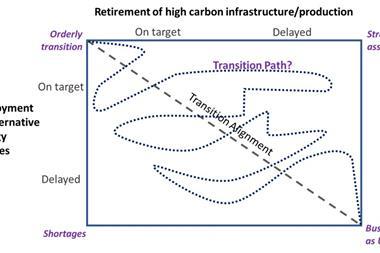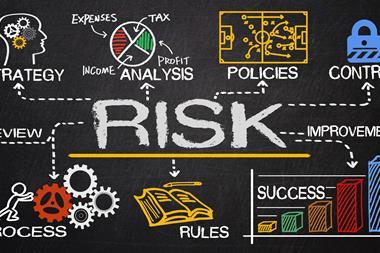Is our permanent state of crisis a distraction from climate commitments, or an opportunity to accelerate the transition?
Risk professionals are the ideal people within the organisation to make sense of the complexities surrounding climate change. As our risk landscape becomes increasingly volatile and unpredictable, their role in managing the risks and opportunities that surround sustainability has never been more pressing.
Over the last there years we have lived through multiple, often interconnected shocks. These include a global pandemic, supply chain and energy crisis, multiple examples of extreme weather and natural catastrophes, a changing geopolitical world order and impending recession.
Together, they are fundamentally changing business attitudes to the risks we are facing and our commitments to protect people and planet.
The ‘perfect storm of high-impact risks’ is throwing many businesses into a permanent state of crisis, according to research by the Chartered Institute of Internal Auditors (IIA).
“Following hard on the heels of the pandemic, Russia’s invasion of Ukraine has intensified supply chain failures, caused a spike in energy prices and fuelled inflation, exacerbating geopolitical and macroeconomic risks,” says IIA chief executive John Wood.
“Meanwhile, the climate emergency threatens to snowball into the next big crisis unless organisations prepare now for the impacts of climate change, with extreme weather events like the record-breaking heatwave this summer, likely to be the new normal in the future. We urge boards to get a grip on the situation and seek the support of their internal audit functions to help them navigate more risky, uncertain, and volatile times ahead.”
The current challenges have exacerbated de-globalisation, creating an environment where supply chain resilience, energy and food security prevail.
The effects of climate change had already highlighted the importance of a green transition, but the Russian invasion of Ukraine has added a new urgency to the shift to renewable sources of energy, according to the latest sigma study.
Time to get real
But building and operating renewable energy assets takes time and involves managing a complex set of risks.
Meanwhile, geopolitical instability could impede near-term efforts to transition to a green economy if it lacks the global cohesion that is needed, and time is not on our side, the IPCC and other scientific bodies continuously warn us.
“The global energy landscape has become a lot more complex,” observes James Wong, director of Strategic Risk Consulting at WTW. “Even back in November 2021 when global leaders were gathered in Glasgow for COP26 to decide the way forward on Net Zero, the energy crisis was already on the horizon.
”It wasn’t really addressed, because the issue is complex enough as it is. There was a fear that by adding in those challenges, it would sidetrack the commitments we were trying to get from the world leaders.”
“The fact we now have more of a geopolitical drift in the energy crisis makes things even more difficult,” says Wong. “The overall view is that a year ago we were still aiming for a world where we all act more consistently and coherently towards the energy transition but now, because of needs that are more urgent, you’re finding a discrepancy and somewhat conflicting parties.”
Inevitably, today’s challenging headwinds make an orderly transition less likely.
Transitioning to renewable sources of energy is not simply a case of ‘flipping a switch’, explain Grant Griffiths, Dylan Campbell, and Alexander Larsen, writing in StrategicRISK on behalf of the IRM Energy SIG. They say it’s time to get real and that the current situation has highlighted a lack of jointed-up thinking, and overly optimistic timelines for achieving environmental targets.
“Net zero was sold as the panacea to the environmental challenges faced by our societies, but it must be asked whether we are moving too quickly without paying due regard to energy security.”
Staying the course
For both public and private sector, the immensity of both near- and longer-term challenges presented by the climate transition can feel overwhelming. This is why risk managers have such a critical role to play when it comes to identifying, assessing and managing the risks and opportunities that surround climate change and transition to Net Zero, both now and into the future.
“Every organisation is stretched right now, but despite the huge uncertainty there is a recognition that we have to change in order to survive,” says Sarah Gordon, chief executive of risk consultancy Satarla. “And therefore, when we’re changing, we must include more climate change- or ESG-friendly ways of doing things.”
Firms need to prioritise what is material to them when it comes to sustainability (measured against the UN’s 17 sustainable development goals for instance), identifying quick wins where possible while also defining longer term objectives.
As companies look to build greater resilience into their supply chains, as an example, it is natural that sustainability should be built into that.
“You might be more willing to give a key supplier certainty in terms of contracts going forward if they can honour lower carbon scopes effectively,” suggests Gordon.
She anticipates that organisations with a more sophisticated approach to sustainability and risk management will rethink their transition plans as the reality of new regulations and a more challenging economy hit home. In particular, she expects to see more achievable and holistic targets, with a recognition that sustainability goes well beyond carbon.
“I’ve come across quite a lot of risk managers who think sustainability is just the environmental bit and it gets that carbon label,” says Gordon. “In part, that’s because you’ve got things like the Carbon Disclosure Project and science-based targets - such as scopes 1, 2 and 3.
“It’s quite easy to cheat the system at the moment and to greenwash if you want to, but the regulations, reporting, verification and validation is improving quickly.”
“Organisations which previously stated they would be Net Zero by 2030 are now beginning to fully realise what that means, and they know they can’t achieve it. We’d expect a mature organisation to be restating their numbers - especially now, due to inflation stress - if they are being really honest to themselves. They will be pumping those targets out into the future, but coming back with really robust transition plans and detailing what they have been able to deliver on so far.”
It takes a risk manager to make sense of the complexities, she thinks.
“With ESG, you need a mechanism through which you determine what you’re looking at and where you need to take action. And really, that is just risk management. If you are already practising enterprise-wide risk management, that forms the inner engine of how you get your organisation to optimise itself for change and seize on any upside along the way.”
Find out all about our upcoming Climate Change & ESG Forum, in partnership with the Institute of Risk Management
World@RISK: ESG & climate Change Forum 2022 - new speakers announced for 15 November
- 1
- 2
- 3
- 4
- 5
- 6
- 7
- 8
- 9
- 10
- 11
- 12
- 13
- 14
 Currently reading
Currently readingClimate change: Unpicking the complexity
- 15
- 16
- 17
- 18





































1 Readers' comment